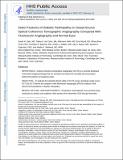| dc.contributor.author | Salz, David A. | |
| dc.contributor.author | de Carlo, Talisa E. | |
| dc.contributor.author | Adhi, Mehreen | |
| dc.contributor.author | Choi, WhooJhon | |
| dc.contributor.author | Baumal, Caroline R. | |
| dc.contributor.author | Witkin, Andre J. | |
| dc.contributor.author | Duker, Jay S. | |
| dc.contributor.author | Waheed, Nadia K. | |
| dc.contributor.author | Moult, Eric Michael | |
| dc.contributor.author | Fujimoto, James G | |
| dc.date.accessioned | 2017-08-02T14:52:45Z | |
| dc.date.available | 2017-08-02T14:52:45Z | |
| dc.date.issued | 2016-04 | |
| dc.date.submitted | 2016-02 | |
| dc.identifier.issn | 2168-6165 | |
| dc.identifier.issn | 2168-6173 | |
| dc.identifier.uri | http://hdl.handle.net/1721.1/110906 | |
| dc.description.abstract | Importance Optical coherence tomographic angiography (OCTA) is a recently developed noninvasive imaging technique that can visualize the retinal and choroidal microvasculature without the injection of exogenous dyes.
Objective To evaluate the potential clinical utility of OCTA using a prototype swept-source OCT (SS-OCT) device and compare it with fluorescein angiography (FA) for analysis of the retinal microvasculature in diabetic retinopathy.
Design, Setting, and Participants Prospective, observational cross-sectional study conducted at a tertiary care academic retina practice from November 2013 through November 2014. A cohort of diabetic and normal control eyes were imaged with a prototype SS-OCT system. The stage of diabetic retinopathy was determined by clinical examination. Imaging was performed using angiographic 3 × 3-mm and 6 × 6-mm SS-OCT scans to generate 3-dimensional en-face OCT angiograms for each eye. Two trained Boston Image Reading Center readers reviewed and graded FA and OCTA images independently.
Main Outcomes and Measures The size of the foveal nonflow zone and the perifoveal intercapillary area on OCTA were measured in both normal and diabetic eyes using Boston Image Reading Center image analysis software.
Results The study included 30 patients with diabetes (mean [SD] age, 55.7 [10] years) and 6 control individuals (mean [SD] age, 55.1 [6.4] years). A total of 43 diabetic and 11 normal control eyes were evaluated with OCTA. Fluorescein angiography was performed in 17 of 43 diabetic eyes within 8 weeks of the OCTA. Optical coherence tomographic angiography was able to identify a mean (SD) of 6.4 (4.0) microaneurysms (95% CI, 4.4-8.5), while FA identified a mean (SD) of 10 (6.9) microaneurysms (95% CI, 6.4-13.5). The exact intraretinal depth of microaneurysms on OCTA was localized in all cases (100%). The sensitivity of OCTA in detecting microaneuryms when compared with FA was 85% (95% CI, 53-97), while the specificity was 75% (95% CI, 21-98). The positive predictive value and the negative predictive value were 91% (95% CI, 59-99) and 60% (95% CI, 17-92), respectively.
Conclusions and Relevance Optical coherence tomographic angiography enables noninvasive visualization of macular microvascular pathology in eyes with diabetic retinopathy. It identified fewer microaneurysms than FA, but located their exact intraretinal depth. Optical coherence tomographic angiography also allowed the precise and reproducible delineation of the foveal nonflow zone and perifoveal intercapillary area. Evaluation of OCTA may be of clinical utility in the evaluation and grading of diabetic eye disease. | en_US |
| dc.language.iso | en_US | |
| dc.publisher | American Medical Association | en_US |
| dc.relation.isversionof | http://dx.doi.org/10.1001/jamaophthalmol.2016.0600 | en_US |
| dc.rights | Creative Commons Attribution-Noncommercial-Share Alike | en_US |
| dc.rights.uri | http://creativecommons.org/licenses/by-nc-sa/4.0/ | en_US |
| dc.source | PMC | en_US |
| dc.title | Select Features of Diabetic Retinopathy on Swept-Source Optical Coherence Tomographic Angiography Compared With Fluorescein Angiography and Normal Eyes | en_US |
| dc.type | Article | en_US |
| dc.identifier.citation | Salz, David A.; de Carlo, Talisa E.; Adhi, Mehreen et al. “Select Features of Diabetic Retinopathy on Swept-Source Optical Coherence Tomographic Angiography Compared With Fluorescein Angiography and Normal Eyes.” JAMA Ophthalmology 134, 6 (June 2016): 644-650 © 2016 American Medical Association | en_US |
| dc.contributor.department | Massachusetts Institute of Technology. Institute for Medical Engineering & Science | en_US |
| dc.contributor.department | Massachusetts Institute of Technology. Department of Electrical Engineering and Computer Science | en_US |
| dc.contributor.department | Massachusetts Institute of Technology. Research Laboratory of Electronics | en_US |
| dc.contributor.mitauthor | Moult, Eric Michael | |
| dc.contributor.mitauthor | Fujimoto, James G | |
| dc.relation.journal | JAMA Ophthalmology | en_US |
| dc.eprint.version | Author's final manuscript | en_US |
| dc.type.uri | http://purl.org/eprint/type/JournalArticle | en_US |
| eprint.status | http://purl.org/eprint/status/PeerReviewed | en_US |
| dspace.orderedauthors | Salz, David A.; de Carlo, Talisa E.; Adhi, Mehreen; Moult, Eric; Choi, WhooJhon; Baumal, Caroline R.; Witkin, Andre J.; Duker, Jay S.; Fujimoto, James G.; Waheed, Nadia K. | en_US |
| dspace.embargo.terms | N | en_US |
| dc.identifier.orcid | https://orcid.org/0000-0003-3859-3094 | |
| dc.identifier.orcid | https://orcid.org/0000-0002-0828-4357 | |
| mit.license | OPEN_ACCESS_POLICY | en_US |
